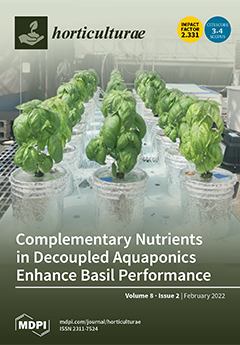The vegetative growth, photosynthetic, and stomatal characteristics were investigated in
Phalaenopsis Queen Beer ‘Mantefon’ to determine light’s influence with calcium ammonium nitrate (CAN) levels under 800 μmol·mol
−1 CO
2. Two lights (150 ± 20 and 300 ± 20 μmol·m
−2·s
[...] Read more.
The vegetative growth, photosynthetic, and stomatal characteristics were investigated in
Phalaenopsis Queen Beer ‘Mantefon’ to determine light’s influence with calcium ammonium nitrate (CAN) levels under 800 μmol·mol
−1 CO
2. Two lights (150 ± 20 and 300 ± 20 μmol·m
−2·s
−1) and CAN levels were employed for 40 weeks: calcium, ammonium, and nitrate levels by 0.90, 0.55, and 2.97 mmol·L
−1 (CAN1), 8.63, 1.11, and 6.05 mmol·L
−1 (CAN2), 12.80, 1.72, and 9.13 mmol·L
−1 (CAN3), and 18.80, 2.27, and 12.20 mmol·L
−1 (CAN4), respectively. The number of leaves increased in the plants grown at 300 ± 20 μmol·m
−2·s
−1 with CAN1 compared to control. Plants grown at 300 ± 20 μmol·m
−2·s
−1 with CAN4 had the lowest number of leaves among all plants. The time to the mature leaf span decreased in the plants grown at 300 ± 20 μmol·m
−2·s
−1 with CAN1. The net CO
2 uptake was higher in the plants grown at 300 ± 20 μmol·m
−2·s
−1 than those grown at 150 ± 20 μmol·m
−2·s
−1 with CAN1–3 conditions. The water-use efficiency is higher in the plants grown with CAN1 than those with CAN2–4 at 300 ± 20 μmol·m
−2·s
−1. The maximum stomatal aperture was the largest in the plants grown at 300 ± 20 μmol·m
−2·s
−1 with CAN1–2 among all plants. Consequently, light levels of 300 ± 20 μmol·m
−2·s
−1 in
Phalaenopsis Queen Beer ‘Mantefon’ must be accompanied by nutrient CAN1 to improve photosynthesis and stomatal activity and promote leaf growth under 800 μmol·mol
−1 CO
2 conditions.
Full article





